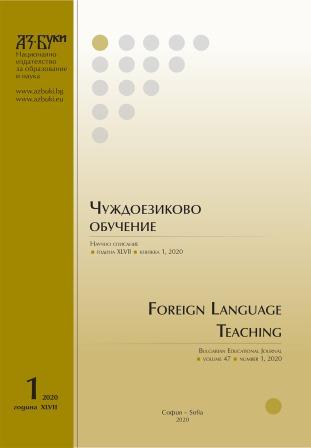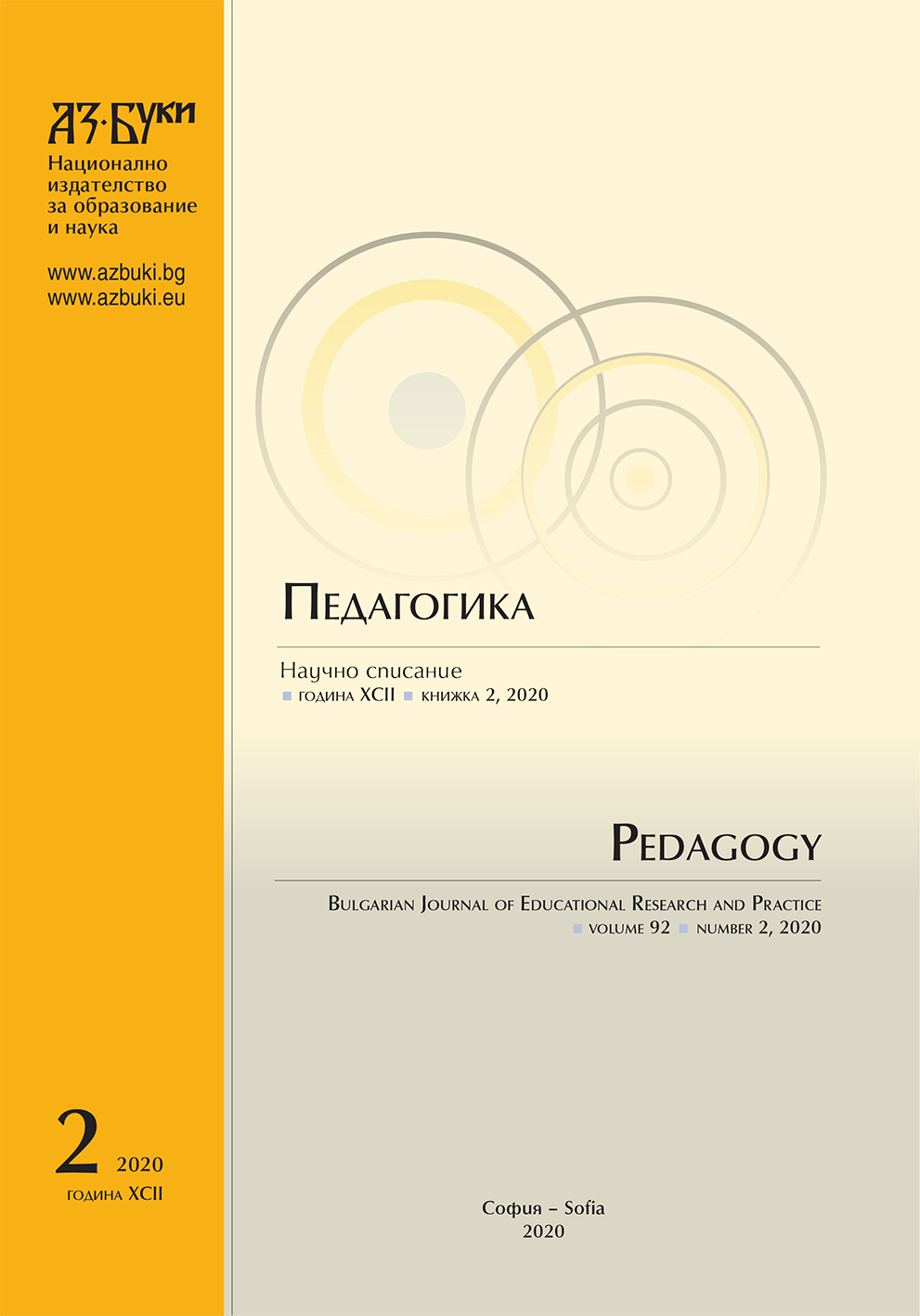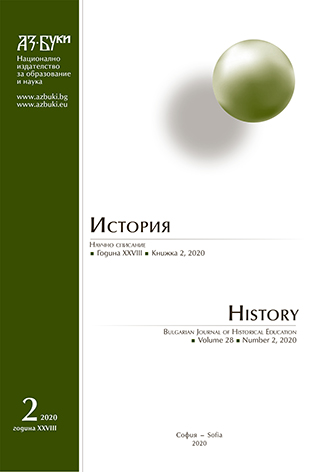
Защо медиация?
The article focuses on actual and very important problem – the aggressive behavior of children and students. The text examines the advantages of mediation compared to other modern ways for solving such problems.
More...We kindly inform you that, as long as the subject affiliation of our 300.000+ articles is in progress, you might get unsufficient or no results on your third level or second level search. In this case, please broaden your search criteria.

The article focuses on actual and very important problem – the aggressive behavior of children and students. The text examines the advantages of mediation compared to other modern ways for solving such problems.
More...
During the last twenty years, Central and Eastern European Online Library (CEEOL) became a leading database and repository offering a highly specialized and comprehensive collection of full text indexed documents in the fields of Humanities and Social Science publications from and about Central and Eastern Europe. Journal articles, eBooks and Grey Literature items are included in 50+ languages, allowing access to the primary source in one repository and fostering the language diversity in academic research and publishing. The dissemination process of the content in CEEOL includes the following discovery systems: Google Scholar, ProQuest´s Serial Solutions, Summon, Primo Central, Alma, EBSCO´s EDS Discovery Service and Knowledge Base, TDNet and OCLC. The CEEOL´s partnership with Clarivate Analytics allows Web of Science editors having access to the CEEOL platform for easier analysis, selection and indexing of CEEOL journals that interest the Web of Science community. Institutional subscribers (states’, universities’, institutes’ libraries, etc.) worldwide appreciate CEEOL for providing researchers, scholars, students, librarians and library patrons the access to indexed and archived Journals, eBooks and Grey Literature documents from and about Central and Eastern Europe by leading academic and scholarly publishers. The Bulgarian collection of journals and books holds a special place in CEEOL due to the high quality of scientific content and the depth and the completeness of the digital archives of the Bulgarian periodicals. CEEOL is a unique source of information for the development of Bulgarian humanities and social sciences for the past over 30 years, and that source could be used more widely in Bulgaria for supporting this development in the future. The study uses a comparative approach and analyzes the results of some of the business analytics tools of the CEEOL system.
More...
The publication explores the algorithm for effective management in the process of inclusive education, the essence of which is a collection of long-term education strategies, and that education should be a long-term project of social justice. The teacher has to take account of situational awareness, and his/her feedback during the methodical unit is not on a personal level. For on the level of a developing process, there is an understanding, comprehension of the learning material by the persons. Its activity is directly related to community inclusion and interdependent from the family – the teacher becomes an active professional.
More...
Inclusive education is a dynamic process that is constantly developing, seeking and implementing different opportunities to meet the needs of all children and to ensure their successful learning and development. In this context, the article examines the importance of music in the inclusive process, of its developmental potential; the help that various musical activities do in the process of overcoming problems in the cognitive and emotional sphere; their role in motivating the child to communicate and stimulating the adoption of values that are particularly important in inclusive school; to create the feeling of being supported and upheld in their efforts; for the successful inclusion of the child in the class and the child’s active participation in the school as well out of it.
More...
The purpose of the article is to examine the restoration of the Bulgarian government in the Wallachian plain in the early fourteenth century. Little-known documentary material is used (the charters of the Hungarian king Carl Robert of October 23, 1317 and March 27, 1329, a letter from Pope John XXII to Wallachian leader Ivanko Basarab from February 1, 1327, etc.) to shed light on the political processes in the Wallachian plain in the first half of the fourteenth century. The text is also based on archaeological researches of towns and villages situated on the left bank of the Danube river. Their architecture and material culture are similar to those of the Bulgarian medieval towns of XII – XIV century, which show a strong relation between the two sides of the great river.
More...
During the second half of the early Neolithic (after 5800 B.C.), the construction of two-storey houses in the Eastern and Central Balkans began. It seems that in the early Neolithic both floors of these houses were used as residential, but in the late Neolithic (after 5500/5400 B.C.) only the upper floor had residential function – the bottom was used for commercial or industrial purposes (storage of products or salt production). Some of the Neolithic houses were deliberately burned. The intentionally burned houses were buried in pits according to the principle pars pro toto (“a part for the whole”). It seems that in the early Neolithic, the pit sanctuaries were located in the periphery of the village, and in the late Neolithic, in ritual complexes situated outside the village. The researchers have no reason to separate the dead Neolithic people from their houses. It follows that the “cremated” houses might lead us to their probably cremated inhabitants - one of the possible explanations of the vast amount of “missing” graves in the Balkan Neolithic.
More...
The article reveals some moments of the life of pop Gruyo Trenchov -an ardent revolutionary who participated in The April uprising of 1876. He is author of a poem, that reflected his memories of the heroic epic.
More...
The political construct established in 1814 – 1815 by Napoleon’s victors aimed at uniting Belgians and Dutch in one country the Netherlands governed by William of the Orange-Nassau dynasty. The construct was theoretically useful for the European balance but at the same time it turned out to be anachronistic because it took into consideration neither the religious differences nor the continuous formation of two completely different nations.
More...
What is the modern understanding of the Islamic fundamentalism today? What is the difference between Islamic fundamentalism and Islamic terrorism? What is the political definition for these two topics? What is the forced public opinion for these social phenomenon? What is political Islam? Where is the common ground between religion and politics? The historical science and the history of the Middle East from the recent past (the last 50-60 years) gives us different answers to these questions compared to the modern political rhetoric from the end of the last century.
More...
This paper presents the historical tendencies in the development of classification of intellectual disability. There is an overview of the different revisions of the International Classification of Diseases (ICD). Additionally, there is comparison among different classifications of intellectual disability based on the revisions transition of ICD.
More...
The article is based on modern technologies and their role in (foreign) language learning in the 21st century. The main objective is to identify ways in which information and communication technologies can facilitate the process of foreign language acquisition and make it faster and more successful. Particular attention has been paid to computer-assisted language learning, internet technologies and mobile-assisted language learning, as they are essential and influential in the creation of foreign language teaching systems, the preparation of (foreign) language teachers and (foreign) language training in general.
More...
We consider peculiarities of poetic meaning creation in the processes of intertextualization and contextualization while analysing a unique case of a polylogue between an academic scholar (A.N. Veselovsky) and poets belonging to different languages and cultures (Vyach. Ivanov, V. Teryan). Veselovsky’s article “From the poetics of a Rose” became a source for Ivanov’s poem “The Rose of Transfiguration”, then it became the basis for the sonnet of V. Teryan. We demonstrate that intertextuality is a complex and non-linear interaction between texts and meanings. The archetypal semantics of the rose and the motives of flame, blood, and also death and resurrection associated with it are contextualized in relation to the Christian holiday, personal myth-making, the tragic events of the Armenian Genocide in the Ottoman Empire. The mythopoetic semantics of the symbol synthesizes various cultures and poetic traditions, creating opportunities for multidimensional semantization and partial translatability of different “texts-echoes”. Expressing new content in different contexts, semantics is based on the same symbols; this leads to a cascade-like actualization of their potential, especially when considering texts connected by intertextual relations in their integrity - as a kind of super-text.
More...
The article studies a phenomenon from the end of XX century in Russian poetry, which is distinguished by its own philosophy and the impulse to revive the refined vocabulary in Russian literature; to bring back to life the cult of beauty, personal life and pleasure, as opposed to the collectivist messages of the Soviet era and the cold breath of the totalitarian winter. The outward manifestations of the works of courtesy poets – the quotient polyphony, the travesties and mystifications, the sarcastic game of their poems – are very reminiscent of postmodern deconstruction. In our view, however, considering its ambition, message, and impulse, this phenomenon is a late avant-garde, realizing its aspirations in a postmodern interior. One of the most characteristic features of the late avant-garde, as well as the avant-garde of the 10s of the XX century, is the rebellious attitude of the spirit, the search for new horizons of meaning. The already known and established is rejected. The skepticism of this art is related to distrust of the adopted measures and categories, hence the negation of the laws, the affirmation of creative improvisation, of the work born in the act of reading. The claim of significance of the word in relation to the fate of culture and art is also preserved.
More...
The specialized understanding of natural kinds (NK) has a theoretical impact on the concept of emergent properties (EP) in particular, as well as on the understanding of the phenomenon of emergence as a whole. The problem is closely related to the tendencies towards their essentialization and theoretical demarcation. The theoretical tension is inevitably manifested in the attempts to consolidate the two concepts, which are generally considered in essentialist terms. A naturalistic, non-essentialist, approach could integrate them into a unified theoretical method, avoiding the problems of their traditional analysis. In the article, NK will be considered as reaction clusters, and EP as complexes of reaction clusters. Both will be directly related to the introduced concepts of reaction potential and stability. The relationship between these concepts will be defined and operationalized, thus explicating the result, considering the phenomenon of emergence as enhancing the reaction potential of a given structure or a complex system, which is in a proportional relation to its net stability.
More...
The paper looks at the problem of national and human security in many parts of Africa today, seen in the inability of most governments to guarantee the adequate protection, peace and well-being of the citizens due in part to foreign dominating ideas. Cabral in his cultural and political thought offered philosophical insights and applied culture to the analysis of security for modern Africa. His theory of security is build upon the struggle for liberation from the colonial ordinance and his philosophy of identity is based on a combination of theory and praxis in the pursuit of reality. This requires the unearthing of the deep cultural roots and causes of things. This harmonization of interests is not just between men and men, but also between men and nature. The question is; what principles and values can best facilitate the crucial sense of security in most African societies?
More...
Our objective is to describe the opportunities for promotion of prosocial behavior as a part of the applied school-based social pedagogy. We discuss the role of social norms, virtual reality in the contemporary context, as well as some fundamentals of the prosocial behavior. On this foundation, we give an example for their integration in the school-based pedagogical work. The project is realized following the framework we suggest for formation of attitudes towards prosocial behavior that can easily be adapted to various environments and groups.
More...
The article presents for the first time theoretical argumentation for the periodization of Bulgarian medieval history. The attempts for such periodization, which are reflected in the content and structure of the summarized scientific publications on the history of medieval Bulgaria from the end of the 19th century to the present day, are reviewed. It has to be concluded that state-political history is a dominant marker. The lower boundary of the Bulgarian medieval history goes back to the time from the earliest history of the Bulgarians and Slavs before the Great Migration of the Peoples, and the upper boundary is the end of the XVII century. In conclusion, the Bulgarian medieval history can be divided in three main periods: Early, High and Late Middle ages.
More...
An attempt to throw light on the early history of Adzhar village,today’s Svezhen, based mainly on four unpublished Ottoman tax registers, is made in the article. The author claims that the earliest documents discovered so far about the existence of Adzhar as a settlement date from the first decades of the XVII century. The village was first mentioned on the pages of an abridged avarız-register from the years 1621 – 1622. Data about the presence of large summer pastures and sheepfolds in the region of Sarnena Sredna Gora Mountain as early as the 16th century show that the foundation of the village can be related to the good conditions for livestock breeding of a peaceful place in the depths of the mountain. It is very likely that part of the inhabitants of Adzhar had been dzheleps, who bred sheep and other cattle for the food needs of the big cities, the army and the Sultan’s Palace. Asa result, raw materials including sheep wool and sheepskins led to the development of a number of crafts.The Orthodox Bulgarian population of Adzhar grew rapidly. Due to the demographic and economic development, a significant literary centre was created there for transcribing and illustrating liturgical books. A church with two priests was built in the village. There is information that in the second half of the 17th century sheep-breeding, crafts such as goat hair processing (mutafcılık) and tailoring, as well as trade and transportation of goods (in exchange of payment – kiracılık)developed in Adzhar.
More...
Тhe article presents an exploration of the “life” of one of the 20th century's symbolic symphonic works in Bulgarian musical culture – composer Petko Staynov’s “Thracian Dances” suite. The starting point of this study is research into some of the archival documents related to the work’s first performance in 1927. The next stage goes through the analysis of the piece’s presence in textbooks from the last third of the last century to the adoption of the Law on Pre-school and School Education. The final stage of this study is focused on the presence of the work and the educational context it is linked to in some of the contemporary Bulgarian textbooks.
More...
The present article focuses on the long standing experimental work of suggestopedia in the area of foreign language teaching at school. It surveys the specific ways of structuring the teaching materials and teaching process for different age groups (first to seventh grade of the Bulgarian school) in compliance with the principles and methods of suggestopedia. It reveals the original character of the main application areas of school suggestopedia related to integrated language and subject teaching (grade one), accelerated formation of initial reading skills in L2 (grade two), the introduction of concert sessions and subsequent activities for children (grades two to seven), the global-artistic approach aimed at developing cultural and communicative competence of learners (grades VI – VII). The experience of the classical period tests its validity against some recent developments of ELT school suggestopedia.
More...